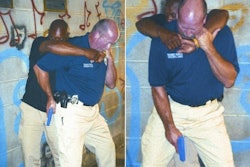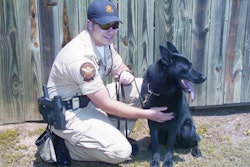It is a damp night and the noxious fumes from a methamphetamine lab are snaking out through the surrounding neighborhood as the cook progresses. The neighbors downwind close their windows as their children complain of headaches, nausea, and sore throats from the acidic odors. The police are called and a patrol unit responds to check things out.
As the officer observes the dilapidated mobile home, he sees the toys and broken down cars scattered about the property. He can smell the raw chemical odors filling the air and called for backup. When the second unit arrives, the mobile home goes dark. All is quiet and it is now apparent the cookers inside are aware of their presence.
The million dollar question is what to do now. It’s likely the meth cookers are busy disassembling the lab and destroying evidence. Do you call for narcotics and wait or do you make contact and investigate? Being action-oriented people, most officers go to the door and investigate. And most of the time, things take their natural course with the officers discovering the lab, arresting the crooks, freezing the scene, and calling out the Narcs to process the lab.
But what if the crook doesn’t answer the door or you smell smoke as the lab ignites? What happens if the crook answers the door and then runs back inside, slamming it behind him? Are you obligated to chase him, knowing full well that there are hazardous chemicals inside and there’s a real possibility the trailer will explode or catch fire? Say you saw toys outside. Are you now obligated to check inside and evacuate the kids? The possibilities are endless, and I don’t have a pat answer for how to answer them. That’s your decision.
But what I do know after working narcotics for seven years and having processed more than 350 clandestine drug labs (mostly methamphetamine), is that meth labs are dangerous, and it’s patrol officers who find the bulk of them.
Unfortunately, patrol officers rarely have the training or equipment to even approach these hazardous crime scenes, so they’re the ones facing the greatest risks. The purpose of this article is to articulate these dangers and help reduce the risks for those involved.
Recipe for Destruction
Although other processes exist, the current prevailing method for making methamphetamine is by the red phosphorus / hydriodic acid / pseudoephedrine recipe. This four-step process requires strong acids, strong bases, flammable solvents, and, during some steps, very explosive and poisonous chemicals.
For obvious reasons, I won’t discuss the particulars of making methamphetamine. Instead, I’ve outlined the hazards to patrol officers associated with each step of the cooking process.
Step One
The first step in making meth is to obtain ephedrine or pseudoephedrine, which is the precursor for making meth. Some cookers can get pharmaceutical-grade ephedrine through the black market. But most cannot, so they extract it from cold or allergy medication—a risky process.
Cookers often use alcohol-based solvents to isolate ephedrine from the rest of the medication. In my experience, this is the step where most lab fires break out. The solvents used are extremely volatile chemicals, which makes them dangerous to begin with. To add to the risk, most meth cookers aren’t chemists, so they don’t know how to handle them safely.
I investigated one lab fire where a man was using his girlfriend’s home in a small trailer park to cook meth. He didn’t want the telltale odors to escape, so the cooker put damp towels across the door and window seams, sealing the odors inside.
As he boiled a pot of acetone on the stove, the fumes, having no outlet, rapidly reached an explosive concentration and the trailer exploded, burning it and two neighboring trailers to the ground.
During the investigation, I recall how the neighbors described the cooker as a young white male running down the street with his hair on fire. I found him hours later in an emergency room with severe burns and a very cranky attitude.
I investigated another lab fire where the cooker wasn’t even heating the denatured alcohol she was using in this first step. It was still just as dangerous. It was a hot day and as the denatured alcohol evaporated, its fumes filled the kitchen. When the refrigerator motor kicked on, it generated a small spark which ignited the fumes and caused an explosion.
Engulfed in flames, the cooker ran outside screaming as she abandoned her two small children in the burning structure. Fortunately, the children ran outside too. But a short time later, the woman died, leaving her children orphaned.
If you as the initial officer were to enter this type of explosive atmosphere, recognize that discharging your firearm could easily ignite these fumes. It would be best to evacuate the structure, freeze the scene, and call for local fire and or hazmat crews. The building should be vented and everyone should stay on the upwind side to avoid contamination from the fumes.
Step Two
Converting ephedrine (or pseudoephedrine) into methamphetamine is the second phase of the manufacturing process. This is accomplished by heating the ephedrine with a strong acid and red phosphorus. As the acid heats up, it releases acidic vapors. Breathing these fumes is very toxic to the lungs. There’s also the danger of exposing your skin and eyes to these acids, which can cause severe chemical burns.
I recall once walking through a drug lab set up in a kitchen. Fortunately, I was wearing a chemical spill suit, chemical resistant boots, gloves, and a respirator. I saw a puddle on the floor that looked like water, but just to be sure, I threw down a pH strip and discovered it was a pool of acid.
Just an hour earlier, children had been evacuated from this house, all of them barefoot. And what of the officers who performed the evacuation? They didn’t have any protective clothing on.
I remember how embarrassed these officers were when we stripped and scrubbed them down, putting their shoes and clothing into plastic bags. Embarrassing but necessary, since they could have contaminated their patrol units, the station, and their families when they went home that night.
Another danger during this phase occurs when the cooker overheats the red phosphorus and produces a poisonous gas called “phosphine.” This deadly gas has killed many drug cookers through the years. Not only is phosphine poisonous, but it’s also explosive when concentrated in a heated beaker. I’ve processed a number of labs where beakers have exploded, splattering their contents on the ceiling and walls.
Imagine entering a room where this highly acidic reaction mixture is dripping down, giving off acidic fumes and phosphine gas. Naturally, when my team responded to the scene we wore chemical spill suits, air tanks, and had a decontamination station already set up. But if you’re the initial responder with just a ballistic vest, you can’t safely enter this environment. The only alternative is to stay outside, get upwind, and call the occupants out.
I was working one lab fire where the heat turned red phosphorus from red to white. When exposed to air, white phosphorus ignites, giving off an extremely acidic gas. It cannot be extinguished with water and a huge cloud of these fumes had spread downwind into the surrounding neighborhood.
The cleanup crew was hours away and patrol worked feverishly to evacuate the residents as we temporarily smothered the flames with dry sand. When the cleanup crew did arrive, they tried to contain the white phosphorus in plastic buckets. But it reignited and melted the buckets. They covered it with sand again and it was hours before they could get the right equipment for the job. Only a highly trained hazmat crew can deal with chemicals like these.
Over the years, I’ve worked many labs that were hard to control. In one where the hazmat crew was trying to identify an acid in a 55-gallon drum, they siphoned a sample into a glass jar and it melted the glass. In another, we found a one-gallon jug of hydrochloric acid sitting on top of a large container of potassium cyanide. These are common chemicals for making PCP, but if they had been mixed, the resulting fumes could have exposed the surrounding neighborhood with the same gas used to execute convicts in the California death chamber.
Step Three
The third phase of methamphetamine manufacturing is called extraction. This involves mixing strong acids with strong bases and organic solvents. Anytime an acid is mixed with a base, there’s going to be a hot and violent reaction. Add in an organic solvent such as Coleman fuel, naphtha, lighter fluid, or other highly flammable liquid multiplies the chance of fire or explosion.
As seen in the prior steps, breathing these fumes or getting these liquids on your skin can lead to severe chemical burns. Imagine living the rest of your life relying on an oxygen tank to breathe. Don’t take the chance with your lungs. Even when being cautious, I’ve found myself in some scary situations at meth cooking sites.
On one occasion, I was wearing a chemical spill suit and SCBA as I carried five-gallon buckets of bi-phase liquid out of a shed. I tripped and spilled about two gallons of solvent out of the entrance onto some live wires leading into the shed. As they shorted out, a small fireball erupted and the surrounding weeds started to burn. Fortunately, the chemicals inside didn’t catch fire and I leaped to safety as my partner doused the flames. Spill suits are great for protecting you from chemicals, but they will melt right onto your skin if exposed to extreme heat.
Step Four
The final phase of home meth production is converting methamphetamine into a solid and filtering it out. Again, flammable solvents, strong acids, and acidic fumes are used in this process and the hazards are the same as in the third phase.
Considering all the dangerous chemicals used, I’m always amazed that drug users willingly snort this stuff up their noses, inject it into their bloodstream, or suck the smoke into their lungs.
The Cooker
Probably one of the more dangerous components of any methamphetamine lab is the cooker himself. Paranoia and violence are common by-products of methamphetamine addiction and the cooker, who is almost certainly high on his own drugs, knows he’s going to state prison when caught.
The cookers themselves rarely know anything about the chemicals they are handling. Once I did meet a cooker who had a master’s degree in chemistry, but he was so wacked on the drugs he didn’t really care. This creates a most dangerous combination.
On one occasion, my team did a “knock and talk” on a trailer where the cooker had a bubbling meth lab inside. He refused to come out. To destroy evidence, he intentionally set the lab on fire. Not a smart move.
My team surrounded the trailer, called the fire department, and waited the cooker out. It wasn’t long before he made a break for it and was successfully arrested. The trailer burned to the ground, but we still prosecuted the cooker on what was left. More importantly, none of our folks were injured.
Make Wise Moves
So here we are again. Your backup arrives, the mobile home goes dark, and all is quiet, but you can bet you’re being watched. Cookers are notorious for their surveillance cameras and listening devices.
In my mind, it’s time to call in the sergeant and enough manpower to surround the place.
Don’t go rushing in. What you need is information to justify your next move. Use your resources such as the fire department, county health, your narcotic officers, and their hazmat teams. When I worked narcotics, I never minded those late night phone calls, even if the sergeant on scene just wanted a question answered.
It doesn’t make sense to enter a lab without the training and the proper protective equipment needed. You’re not likely to die if you do get exposed. It’s just that you’re taking a terrible risk if caught in an explosion or fire. And who wants to plant the seeds of cancer that might develop in the years to come? Is it really worth the risk over a case where the cooker may only get two to three years in state prison? Then again, if there are children involved, that changes things in my book.
Only the officer on scene can make the judgment. It’s your call; make it.
[SIDEBAR]
Do Not Touch
The following is a list of common chemicals and equipment used in clandestine methamphetamine labs. Many of these chemicals can be found in a hardware store and have legitimate uses, so call in an expert if you aren’t sure.
If found in a car, shed, residence, or any other location, patrol officers should stay upwind and be careful not to touch these items if they appear contaminated.
Warning: Never attempt to handle or disassemble any lab components without the proper training, safety gear, and a decontamination station set up. Call in your narcotic officers and hazmat team.
• Cold or allergy medication containing ephedrine or pseudoephedrine.
• Alcohol base solvents such as the auto gas additive Heat, acetone, or denatured alcohol.
• Unlabeled bottles or jars containing a clear liquid over white sediment.
• Coffee filters containing chunky sediment (usually the same color as the cold medication pills used).
• Glass pots and pans containing a white residue.
• Heat-resistive glassware such as coffee pots, flasks, and beakers containing red or amber contamination.
• Unlabeled bottles or jars containing bi-phase liquids, usually clear or tinted green over amber. These liquids are often acidic, corrosive, or flammable.
• Acidic or corrosive chemicals stored in unmarked bottles or jars.
• Contaminated plastic tubing, buckets, spatulas, wooden spoons, etc., stained amber or red.
• Hot plates with amber or red contamination on them.
• Twisted coffee filters or sheets stained amber and containing chunky red phosphorus.
• Plastic jars labeled red phosphorus.
• Glass jars labeled iodine crystals.
• Plastic jar containing granular lye.
• Organic solvents such as Coleman fuel, naphtha, freon, white gas, butane, paint thinner, methyl ethyl ketone, lighter fluid, etc.
• A plastic soda bottle with a tube secured to the top and containing a yellow liquid over gray sludge.
• Contaminated funnels and coffee filters.
• Plastic jug containing muriatic acid (hydrochloric acid).
• Plastic jug containing Drano (sulfuric acid).
• Rock salt.
• Aluminum foil.
• Amber-stained scales, plastic baggies, pay-owe sheets, spoons, scrapers, etc.
• Filters containing amber or white methamphetamine.
• Amber or red contaminated gloves, clothing, shoes, breathing masks, etc.
Dave Street is a senior detective and 28-year veteran with the Riverside County (Calif.) Sheriff’s Department. He worked major narcotics for seven years and currently works as a “crimes against persons” detective out of the RSO Moreno Valley station.















